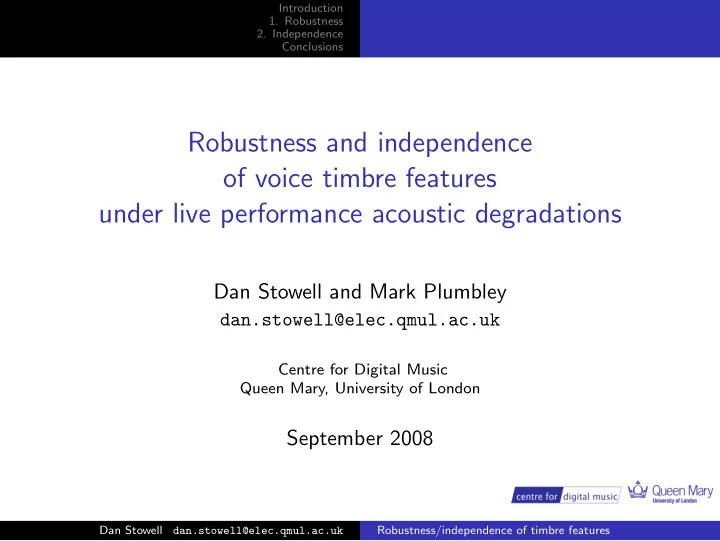

Introduction 1. Robustness 2. Independence Conclusions Robustness and independence of voice timbre features under live performance acoustic degradations Dan Stowell and Mark Plumbley dan.stowell@elec.qmul.ac.uk Centre for Digital Music Queen Mary, University of London September 2008 Dan Stowell Robustness/independence of timbre features dan.stowell@elec.qmul.ac.uk
Introduction 1. Robustness 2. Independence Conclusions Introduction: Motivation ◮ Analysing timbre of performing voice ◮ Create a timbre space ◮ Input to classifier ◮ Control effects ◮ Many acoustic features available ◮ Cannot use all at once ◮ Desire those which 1. Are most robust against noise/echo/etc 2. Give us the most “information” ◮ Two experiments on continuous-valued features Dan Stowell Robustness/independence of timbre features dan.stowell@elec.qmul.ac.uk
Introduction 1. Robustness 2. Independence Conclusions Introduction: Two experiments Datasets Singing Feature extraction Robustness experiment Acoustic Simulated Audio Speech timbre degradations frames features Independence experiment Beatboxing Dan Stowell Robustness/independence of timbre features dan.stowell@elec.qmul.ac.uk
Introduction 1. Robustness 2. Independence Conclusions Features investigated 23 acoustic timbre features: ◮ MFCCs ◮ Spectral centroid ◮ Spectral spread ◮ Spectral crest factors (overall and subband) ◮ Spectral percentiles: 25%, 50%, 90%, 95% ◮ High-frequency content (HFC) ◮ Zero-crossing rate (ZCR) ◮ Spectral flatness ◮ Spectral flux Dan Stowell Robustness/independence of timbre features dan.stowell@elec.qmul.ac.uk
Introduction 1. Robustness 2. Independence Conclusions Robustness: method ◮ 7 types of degradation: Measure absolute % deviation within each frame. ◮ White noise ◮ Crowd noise Two ways of comparing: ◮ Music noise ◮ Ranking ◮ Clipping distortion ◮ Delay (+ Kendall’s W test) ◮ Delay with feedback ◮ Pairwise comparison ◮ Reverb (+ Wilcoxon Signed-Rank test) (Each at 4 effect levels) Dan Stowell Robustness/independence of timbre features dan.stowell@elec.qmul.ac.uk
Introduction 1. Robustness 2. Independence Conclusions Robustness: results Dataset Singing Speech Beatboxing BEST crst1 crst1 crst1 25%ile mfcc1 mfcc5 crst2 crst2 mfcc7 ZCR 25%ile mfcc1 mfcc1 spread mfcc3 95%ile crest crest spread 50%ile mfcc8 crest mfcc5 spread 50%ile crst3 mfcc6 crst3 ZCR mfcc4 90%ile mfcc7 25%ile centroid mfcc3 crst2 ... ... ... Dan Stowell Robustness/independence of timbre features dan.stowell@elec.qmul.ac.uk
Introduction 1. Robustness 2. Independence Conclusions Robustness: results Dataset Singing Speech Beatboxing ... ... ... centroid mfcc3 crst2 mfcc3 95%ile crst3 crst4 centroid 50%ile mfcc5 crst4 95%ile mfcc8 90%ile crst4 mfcc7 mfcc4 centroid flatness mfcc8 90%ile mfcc4 mfcc2 ZCR mfcc2 mfcc6 mfcc2 flux flatness flatness mfcc6 flux flux WORST HFC HFC HFC Dan Stowell Robustness/independence of timbre features dan.stowell@elec.qmul.ac.uk
Introduction 1. Robustness 2. Independence Conclusions Robustness: results ◮ Some good: ◮ Spectral crest factors ◮ Odd-numbered MFCCs ◮ Some poor: ◮ HFC ◮ Spectral flatness ◮ Spectral flux ◮ Some even-numbered MFCCs ◮ Some interact with signal type: ◮ ZCR ◮ Some spectral percentiles Dan Stowell Robustness/independence of timbre features dan.stowell@elec.qmul.ac.uk
Introduction 1. Robustness 2. Independence Conclusions 2. Independence ◮ Second experiment: Which features “give us the most information”? ◮ There may be redundancy between acoustic features ◮ Correlation is one way to probe this – but limited (monotonic) ◮ Information theory: analyse dependencies more generally ◮ Again, two comparisons: ◮ Pairwise ◮ Ranking (feature selection) Dan Stowell Robustness/independence of timbre features dan.stowell@elec.qmul.ac.uk
Introduction 1. Robustness 2. Independence Conclusions Independence: method (a) Mutual information: ◮ Given feature X and feature Y : ◮ If I know the value of X , how far does that decrease my uncertainty about the value of Y ? ◮ Defined from the probability distributions: � p ( x , y ) � � � I ( X ; Y ) = p ( x , y ) log p ( x ) p ( y ) y ∈ Y x ∈ X ◮ We can estimate this value from our data ◮ Tell us which features have informational overlap Dan Stowell Robustness/independence of timbre features dan.stowell@elec.qmul.ac.uk
Introduction 1. Robustness 2. Independence Conclusions Independence: method (b) Conditional entropy: X Y Z W Entropy of W conditional on X , Y , Z H ( W | X , Y , Z ) = H ( X , Y , Z , W ) − H ( X , Y , Z ) �≡ H ( W ) Feature selection by greedy rejection: reject one feature at a time, according to lowest conditional entropy Dan Stowell Robustness/independence of timbre features dan.stowell@elec.qmul.ac.uk
Introduction 1. Robustness 2. Independence Conclusions Independence: results Singing Speech Beatboxing BEST crst2 crst2 crst1 crst3 95%ile mfcc1 crest crst1 crst2 mfcc6 crst3 mfcc5 mfcc8 mfcc8 mfcc7 mfcc3 mfcc3 mfcc3 crst1 mfcc7 mfcc8 mfcc7 mfcc6 mfcc4 95%ile mfcc4 mfcc6 mfcc4 mfcc5 crest mfcc5 crest spread mfcc1 mfcc1 crst3 spread spread 95%ile 90%ile 90%ile crst4 crst4 crst4 90%ile centroid centroid centroid ZCR ZCR ZCR 50%ile 50%ile 50%ile WORST 25%ile 25%ile 25%ile Dan Stowell Robustness/independence of timbre features dan.stowell@elec.qmul.ac.uk
Introduction 1. Robustness 2. Independence Conclusions Summary 1. Robustness ◮ Ranking (median deviation) ◮ Pairwise comparison (Wilcoxon Signed Rank test) 2. Independence ◮ Pairwise comparison (mutual information) ◮ Feature selection (conditional entropy) Dan Stowell Robustness/independence of timbre features dan.stowell@elec.qmul.ac.uk
Introduction 1. Robustness 2. Independence Conclusions Conclusions ◮ Suggested feature-set for performing voice: ◮ Spectral crest factors + MFCCs + 95-percentile (“rolloff”) ◮ Spectral crest factors perform well ◮ Spectral centroid less useful than expected ◮ Some features’ performance interacts with signal type ◮ Information-theoretic measures useful for probing dependencies Dan Stowell Robustness/independence of timbre features dan.stowell@elec.qmul.ac.uk
Recommend
More recommend